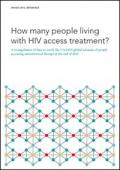Publications - Released in 2016
Among the most closely watched indicators of the global AIDS response is the number of people on antiretroviral therapy. Antiretroviral medicines allow people living with HIV to live long and healthy lives. The medicines can also reduce the amount of HIV in the bloodstream to undetectable levels. Having such a low viral load greatly reduces the chance that a person living with HIV will transmit the virus to someone else.
The current global target, agreed by the United Nations General Assembly in June 2016, is for 30 million people living with HIV to access treatment by 2020. UNAIDS is mandated by the United Nations General Assembly to track global progress against this and other global targets. A majority of countries regularly report treatment numbers and other data against a standard set of indicators to UNAIDS through the Global AIDS Response Progress Reporting (GARPR) system. UNAIDS works in collaboration with the World Health Organization (WHO), the United Nations Children’s Fund (UNICEF) and other partners to validate these reports ahead of publication. For the minority of countries that do not provide reports, UNAIDS estimates their treatment numbers using a variety of data sources.
Downloads
Organizations
- Joint United Nations Programme on HIV/AIDS (UNAIDS)






